Modeled response of talik development under thermokarst lakes to permafrost thickness on the Qinghai-Tibet Plateau
Feng Ling, QingBai Wu, FuJun Niu, TingJun Zhang
1. Institute of Plateau Meteorology, China Meteorological Administration, Chengdu, Sichuan 620071, China
2. School of Mathematics and Statistics, Zhaoqing University, Zhaoqing, Guangdong 526061, China
3. State Key Laboratory of Frozen Soil Engineering, Cold and Arid Regions Environmental Engineering Research Institute, Chinese Academy of Sciences, Lanzhou, Gansu 730000, China
4. College of Earth and Environmental Sciences, Lanzhou University, Lanzhou, Gansu 730000, China
Modeled response of talik development under thermokarst lakes to permafrost thickness on the Qinghai-Tibet Plateau
Feng Ling1,2*, QingBai Wu3, FuJun Niu3, TingJun Zhang4
1. Institute of Plateau Meteorology, China Meteorological Administration, Chengdu, Sichuan 620071, China
2. School of Mathematics and Statistics, Zhaoqing University, Zhaoqing, Guangdong 526061, China
3. State Key Laboratory of Frozen Soil Engineering, Cold and Arid Regions Environmental Engineering Research Institute, Chinese Academy of Sciences, Lanzhou, Gansu 730000, China
4. College of Earth and Environmental Sciences, Lanzhou University, Lanzhou, Gansu 730000, China
Permafrost thickness under identical climates in cold regions can vary significantly because it is severely affected by climate change, topography, soil physical and thermal properties, and geothermal conditions. This study numerically investigates the response of ground thermal regime and talik development processes to permafrost with different thicknesses under a thermokarst lake on the Qinghai-Tibet Plateau. On the basis of observed data and information from a representative monitored lake in the Beiluhe Basin, we used a heat transfer model with phase change under a cylindrical coordinate system to conduct three simulation cases with permafrost thicknesses of 45 m, 60 m, and 75 m, respectively. The simulated results indicate that increases in permafrost thickness not only strongly retarded the open talik formation time, but also delayed the permafrost lateral thaw process after the formation of open talik. Increasing the permafrost thickness by 33.3% and 66.7% led to open talik formation time increases of 83.66% and 207.43%, respectively, and resulted in increases in the lateral thaw duration of permafrost under the modeled thermokarst lake by 28.86% and 46.54%, respectively, after the formation of the open taliks.
permafrost thickness; thermokarst lakes; talik development; lateral thaw; modeling
1 Introduction
Thermokarst lakes are an impressive sight and are one of the dominant features of the high-latitude and high-altitude landscapes where ice-rich permafrost exists. These lakes form as a result of thawing of ice-rich permafrost or melting of massive ground ice, and their basins expand by conduction of heat from lake water into adjacent permafrost. The origin, growth, geometry, distribution, drainage, age, and impact of thermokarst lakes in high-latitude permafrost regions have been studied by many researchers since the late 1940s (e.g., Black and Barksdale, 1949; Hopkins, 1949; Johnston and Brown, 1966; Sellmannet al., 1975; Mackay, 1997; Hinkelet al., 2003; Yoshikawa and Hinzman, 2003; Ling and Zhang, 2004a; Burn, 2005; Jorgenson and Shur, 2007; West and Plug, 2008; Kokeljet al., 2009; Hinkelet al., 2012a, 2012b). However, thermokarst lakes and their impacts in high-altitude permafrost regions were rarely studied before 2006, largely due to an almost complete lack of below-lake temperature measurements.
More than 1,500 lakes are distributed on the Qinghai-Tibet Plateau (QTP). The majority of thelakes in permafrost regions are thermokarst features (Zhouet al., 2000; Bianet al., 2009; Liuet al., 2009). The properties and impacts of thermokarst lakes on the QTP have captured the interest of many investigators recent years. A thermokarst lake in the Beiluhe Basin was confirmed as a representative lake and has been monitored since April 2006 by the State Key Laboratory of Frozen Soil Engineering, Cold and Arid Regions Environmental and Engineering Research Institute, Chinese Academy of Sciences (Linet al., 2010a). On the basis of the extremely valuable data and information from this monitoring project, Linet al.(2010b, 2011, 2013) analyzed the lakeshore collapse, water temperature variation, and the changes in ground temperature beneath and around the lake, and examined the ice thickness and documented the yearly change in the lake-surface and lake-bottom temperatures; they then simulated the influence of thermokarst lakes on permafrost degradation in the Beiluhe Basin. Niuet al.(2011, 2013) estimated the age of the representative thermokarst lake and investigated broader thermokarst lake distribution, depth, thickness of lake ice in winter, and the mean annual lake-bottom temperatures in the region from the Kunlun Mountain Pass to Fenghuo Mountain along the Qinghai-Tibet corridor, and determined the area and quantity of thermokarst lakes from the Chumaerhe to Fenghuoshan Mountain section along the Qinghai-Tibet Plateau Highway. Linget al.(2012) numerically investigated the rate of talik development beneath the representative lake, the time taken for an open talik to form beneath the lake, and the rate of lateral thaw of permafrost after the open talik had formed. Huanget al.(2011, 2012) investigated thermokarst lake ice growth and decay, and the inner structure of ice samples, and analyzed the effective thermal conductivities of thermokarst lake ice and the effect of the direction of heat conduction.
The existence of permafrost is a result of the history and present state of the energy balance at the Earth’s surface, measured by the surface temperature and the deep Earth heat flow, and the appropriate soil conditions which cause it to grow from the ground surface downward (Lunardini, 1995). Permafrost on the QTP is extremely sensitive to climate change, environmental change, and any anthropogenic surface disturbance because it is relatively warm, thin, and ice-rich (Cheng and Wu, 2007; Wu and Zhang, 2008, 2010). The Beiluhe Basin is located in the interior of the QTP, and about 21 km of the Qinghai-Tibet Railway passes through this area. More than 30 thermokarst lakes are distributed along both sides of the railway, and most of lakes are deeper than the maximum lake ice thickness. The relatively warm lake water can cause considerable disturbance to the surrounding permafrost.
Permafrost thickness is severely affected by climate change, topography, geothermal flux, and soil physical and thermal properties such as soil type, dry bulk density, water content, and unfrozen water content. Permafrost thickness under identical climates in a certain district can have striking differences (Lunardini, 1981, 1995; Lachenbruch and Marshall, 1986; Williams and Smith, 1989; Osterkamp and Gosink, 1991; Ling and Zhang, 2004b; Osterkamp, 2005). For example, measurements from two boreholes only 100 m apart in the Liangdaohe District on the QTP showed that the permafrost thickness and permafrost thermal regimes were very different (Liet al., 1996; Li and Wu, 2004). Similarly, over permafrost of different thicknesses, the impact of thermokarst lakes on the ground thermal regime and talik development beneath thermokarst lakes can vary significantly. On the basis of observed data and information from the monitoring project in the Beiluhe Basin, the main objective of this study was to simulate the response of the ground thermal regime and talik development process under QTP thermokarst lakes to permafrost with different thicknesses, using a numerical model.
2 Model description and data sources
Because thermokarst lakes in the Beiluhe Basin are typically elliptical in shape (Linet al., 2010b; Niuet al., 2011), we used a two-dimensional heat transfer model with phase change under a cylindrical coordinate system to simulate the permafrost thermal regime and talik development under thermokarst lakes. This model has been previously used to investigate the impacts of shallow thaw lakes on permafrost thermal regime and talik development on the Alaskan Arctic coastal plain and on the QTP, and has achieved satisfactory results (Ling and Zhang, 2003, 2004a; Linget al., 2012). Assuming there is no annular heat flow in the cylindrical coordinate system, the governing equations for the ground thermal regime can be written in a unique form:

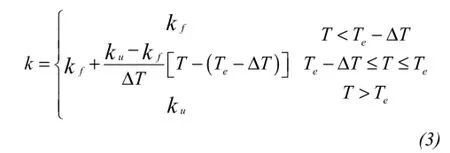
where the subscriptsfandurepresent the frozen and unfrozen phases, respectively;Tis temperature (°C);tis time in seconds;ris the radius from the centerline of the lake (m);χis the depth from the ground surface downward (m);Cis the volumetric heat capacity (J/(m3·°C);kis the thermal conductivity (W/(m·°C);Dis the total simulation time after lake formation (years);XandRare the total depth and radius of the analysis domain (m);Teis the freezing temperature and is set at 0 °C;∆Tis the width of the temperature interval in which the phase change occurs (°C) and is assumed to be 0.5 °C;Lwis the mass specific latent heat of water (J/g);ρbis the dry bulk density of soil (kg/m3);Wis the total water content percent of soil by mass; andWuis the unfrozen water content percent of soil by mass at the temperature intervalTe−∆T.
Permafrost thickness in the Beiluhe Basin is approximately 20-80 m, with a geothermal gradient of 0.015-0.048 °C/m and an active layer depth of 1.8-3.0 m. The permafrost temperature is within 2.0 °C below the freezing point of water. The mean annual ground temperature at a depth of 15.0 m ranges between −1.6 °C and −0.9 °C. The monitored thermokarst lake in the Beiluhe Basin lies in high-ice-content terrain within the continuous permafrost zone. The lake is elliptical in shape with its major axis of about 150 m and its minor axis of about 120 m. It is classified as a closed perennial type and has water depths up to 2.0 m. The average ice thickness is about 0.45 m to 0.5 m during the entire cold season. This thermokarst lake is viewed as a representative of thermokarst lakes in the Beiluhe Basin (Linet al., 2010a, 2011; Niuet al., 2011). The pre-existing permafrost below the monitored lake center has thawed entirely, and the adjacent permafrost is eroding and degrading (Linet al., 2010b).
On the basis of the above data, a lake with a radius 60 m and a water depth 2.0 m was used in our cylindrical model. The radius of the analysis domain was set asR= 200 m, 140 m away from the lakeshore to reduce the effect of the right-side vertical boundary condition. Permafrost thicknesses,H0, of 45 m, 60 m, and 75 m were selected. The depth of the analysis domain was set asX= 100 m, at least 25 m below the permafrost base, to reduce the effect of the lower boundary condition. The upper boundary was set at a depth of 0.5 m below the lake bottom (i.e., 2.5 m below the ground surface) off the shore, and at a depth of 0.5 m below the ground surface on the shore (Figure 1). Observed ground temperature data at these depths were available for our modeling. Note that only half of the analysis domain is shown in figure 1 and analyzed numerically, due to the axial symmetric nature of the domain about the centerline of the lake. It should be noted that a natural thermokarst lake has a central deep pool and a shallow nearshore zone. The lake bottom temperature in the central deep pool is higher than that in the shallow nearshore zone (Linget al., 2012), but the effect of the shallow nearshore zone of the studied lake was neglected in this study. Thus, the rate of the talik development process may be overestimated here.
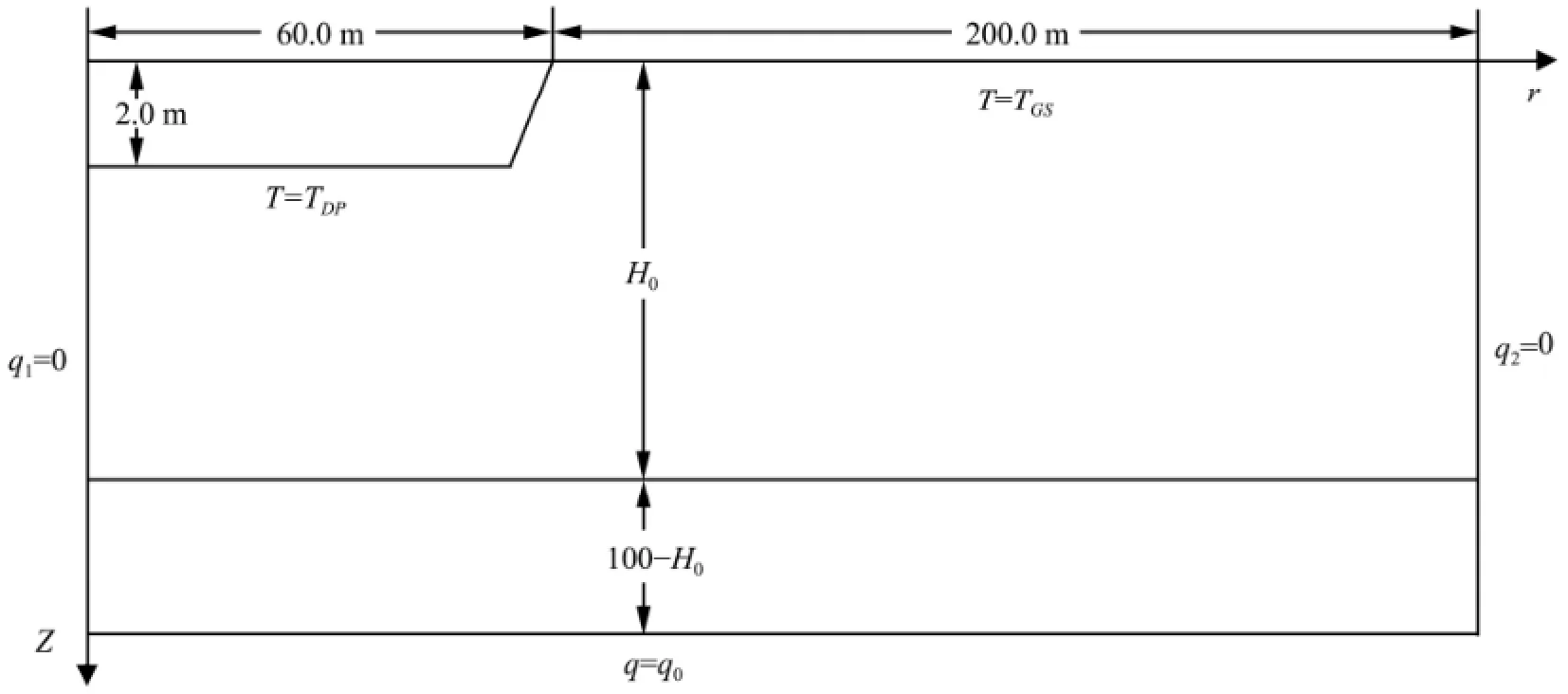
Figure 1 Schematic illustration of analysis domain and boundary conditions. The upper boundaries were set at a depth of 2.5 m in the central deep pool with 2.0 m deep water, at a depth of 1.5 m in the shallow nearshore zone with 1.0 m deep water, and at a depth of 0.5 m below the ground surface on the shore, respectively. Permafrost thickness isH0in m
Based on previous engineering geological investigations in the Beiluhe Basin and field-drilled coresnear the study lake (Niuet al., 2002; Linet al., 2010b; Sunet al., 2013), we divided the analysis domain into four sub-domains. The soil types in the analysis domain and their physical properties were chosen based on the drilled core data. The thermal parameters of the soils were taken from previous experimental investigation reports on the QTP (Xu and Deng, 1991). These results are summarized in table 1.

Table 1 Physical and thermal parameters of soils used in the current study
The ground temperatures below the lake bottom off the shore,TLB, and below the ground surface on the shore,TGS, changed according to the sinusoidal equations(4)and(5)based on the observed ground temperature data from January 2007 through December 2013:
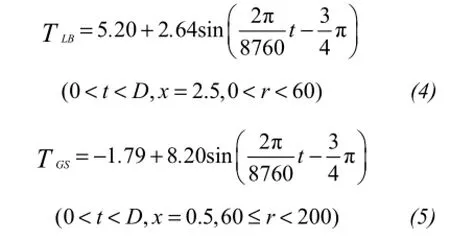
The lower boundary condition was:

The left and right boundary conditions were treated as zero heat flux boundary conditions:
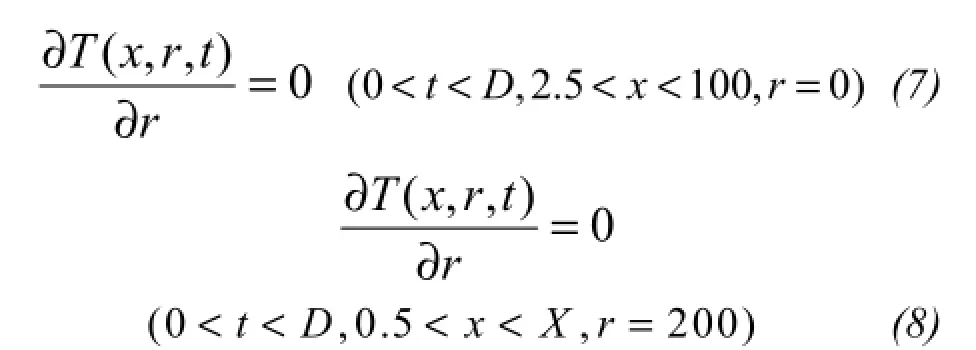
whereqis the geothermal heat flux (W/m2).
This study focused on the response of the ground thermal regime and talik development to changes in permafrost thickness under a thermokarst lake. Three simulation cases of H45, H60, and H75 were conducted by setting the permafrost thickness as 45 m, 60 m, and 75 m, respectively (Table 2). The initial ground thermal gradients on the permafrost base were calculated from the observed mean annual ground temperature of −1.43 °C at a depth of 15 m and the permafrost thickness,H0. The heat fluxes on the lower boundary were obtained based on the continuous temperature condition and the conservation of energy condition on the permafrost base at the initial time. The permafrost thicknesses and the corresponding ground thermal gradient values on the permafrost base at the initial time and the heat fluxes on the lower boundary are summarized in table 2.

Table 2 Simulation cases and the corresponding permafrost thicknesses, ground thermal gradients on permafrost base at the initial time, and the heat fluxes on the lower boundary used in the current study
The governing equations(1)-(8)were solved using a combination of the Galerkin finite-element method and a finite-difference method. It was initially assumed that the permafrost thickness wasH0(Table 2), and there was no thermokarst lake over the permafrost. The initial ground temperature values for nodes in the upper 15.0 m were the measured mean annual ground temperatures in the corresponding depths from January 2007 through December 2013. The initial temperatures for nodes below 15.0 m were the interpolated values based on the observed mean annual ground temperature of −1.43 °C at the depth of 15 m and the calculated thermal gradients in the permafrost zone and in the unfrozen zone.
The model was run using the initial and boundary conditions until the soil thermal regime reached an equilibrium configuration with the corresponding physical and thermal parameters and boundary conditions. In this study, the criterion for equilibrium was that the maximum temperature difference in each node between two successive time steps was less than 0.001 °C. Then the equilibrium thermal regime was used as the initial condition, and a thermokarst lake with a lake radius of 60.0 m and a water depth of 2.0 m was assumed to be over the permafrost (Figure 1). The model was solved step-by-step using the boundary conditions(4)-(8). A time step of 12 hours was used with a total simulation period ofD= 900 years. The spatial step varied from 0.5 m to 3 m along theχ-axis direction, and from 3 m to 5 m along ther-axis direction.
3 Results
The simulated talik thicknesses and ground thermal regimes beneath the thermokarst lake on the last day of year 200 and year 600 for simulation cases H45, H60, and H75 are presented in figure 2. Thermokarst lakes are a significant heat source to permafrost and talik. In this simulation, a bowl-shaped talik formed under the thermokarst lake and the talik thickness increased substantially over time (Figures 2a-2c, 2f). The downward and upward advancing 0 °C isotherms merged near the lake centerline (i.e., an open talik formed) in a certain year (Figure 2a). The lake continued to thaw the permafrost laterally under the lake, and the volume of open talik beneath the lake increased gradually with time after the formation of the open talik. Permafrost below the lake was predicted to thaw completely in a certain year and permafrost under the lakeshore would thaw laterally with time (Figures 2d-2e).
Due to the identical temperatures in the lake bottom and the large differences in permafrost thickness, the ground and talik temperatures under the lake at a certain time in the three simulation cases were very different. As a result, the open talik formation times and the lateral thaw processes for the three simulation cases had very large differences.
Variations in the maximum top and bottom thaw thicknesses with time for simulation cases H45, H60, and H75 are presented in figure 3. Increasing the permafrost thickness from 45 m to 60 m and 75 m resulted in the open talik formation time increasing from 202 years to 371 years and 621 years, respectively, with the corresponding maximum top thaw depths increasing from 40.5 m to 52.3 m and 65.3 m. This means that increasing the permafrost thickness by 33.3% and 66.7% led to the open talik formation time increasing by 83.66% and 207.43%, respectively. Increasing the permafrost thickness strongly increased the open talik formation time. For each simulation case, the permafrost top thaw rate was very high in the first 30 years after the formation of the lake because the lake bottom temperature was raised from a mean annual value of −1.79 °C to a mean annual value of 5.20 °C. There was a relatively uniform thaw rate during the next 150-570 years from year 30 after the formation of the lake to the last 10 to 30 years before the downward and upward advancing 0 °C isotherms merged, depending on the permafrost thickness; then there was a relatively high thaw rate during the last 10 to 30 years before the open talik formation. The permafrost bottom thaw rate was very low during the permafrost thawing process after the formation of the thermokarst lake, except in the last 10 to 30 years before the formation of the open talik, reflecting the long distance from the lake bottom to the permafrost base, and the higher permafrost temperature and thinner permafrost thickness.
In order to further compare the response of talik development and ground thermal regime to permafrost with different thicknesses, table 3 shows the simulated mean permafrost top thaw rate and the corresponding mean bottom thaw rate under the modeled thermokarst lake for simulation cases H45, H60, and H75. Increasing the permafrost thickness of 45 m by 33.3% and 66.7% resulted in a mean top thaw rate of 19.06 cm/a and decreases of 28.86% and 46.54%, respectively, and a mean bottom thaw rate of 2.23 cm/a and decreases of 6.73% and 30.04%, respectively.
Figure 4 shows the simulated profiles of the taliks on the last day of year 450 for simulation cases H45, H60, and H75, to illustrate the responses of the talik development and permafrost lateral thaw process to permafrost with different thicknesses beneath the modeled thermokarst lake. In simulation case H45, permafrost below the lake thawed completely and even the part of the permafrost below the lakeshore thawed. In simulation case H60, an open talik formed under the lake, the lake continued to thaw the permafrost laterally under the lake, and the minimum horizontal dis-tance between the talik margin and the lake centerline was up to 52.3 m. The volume of the open talik beneath the lake increased gradually with time and the permafrost below the lake was predicted to soon thaw completely. In contrast, in simulation case H75 the open talik had not formed by the last day of year 450 and the maximum top thaw depth and bottom thaw thicknesses were 49.0 m and 3.5 m, respectively. The differences in ground thermal regimes caused by the differences in permafrost thicknesses were thus significant.
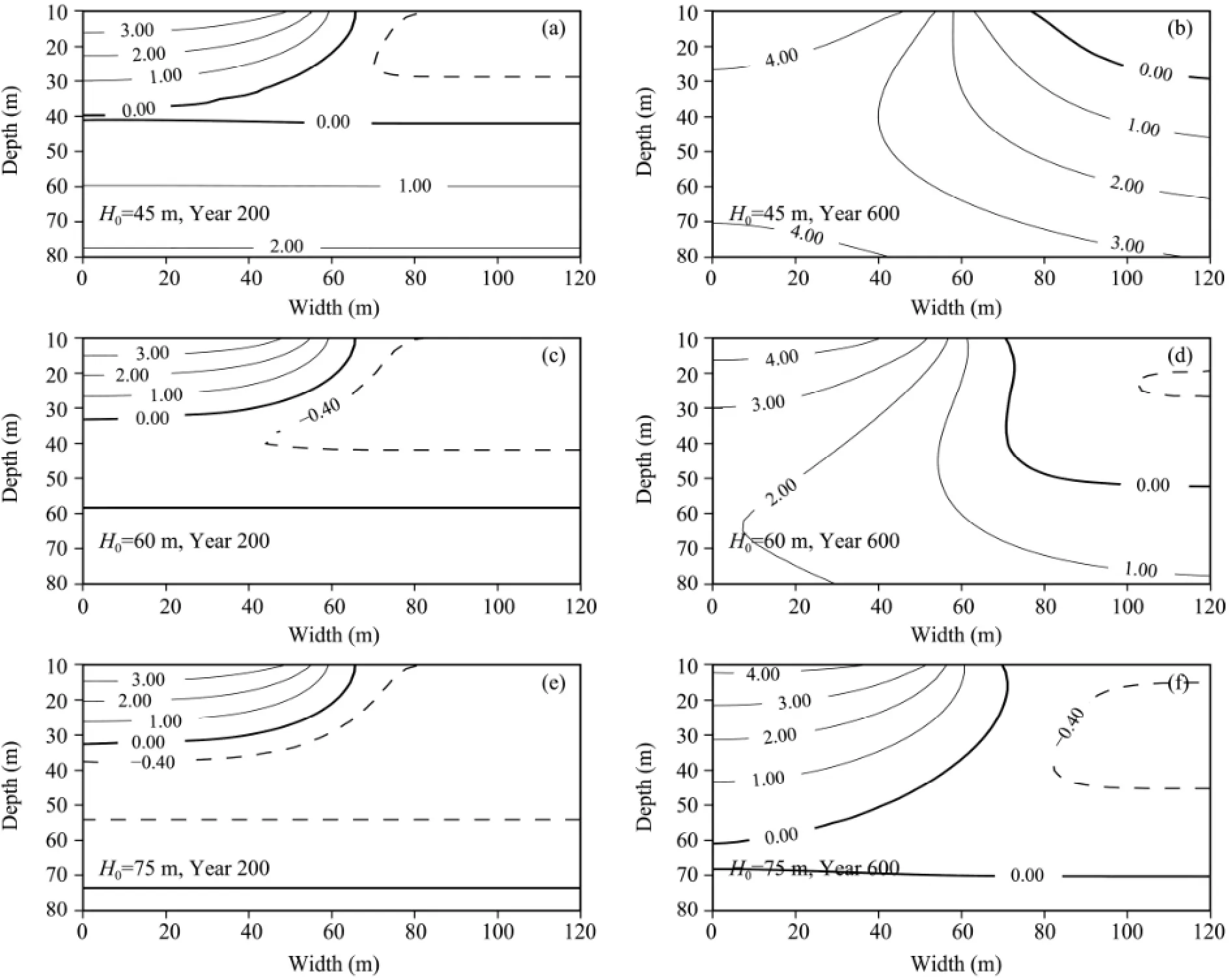
Figure 2 Simulated talik thicknesses and ground thermal regimes under the modeled thermokarst lake on the last days of year 200 and year 600 for simulation cases H45, H60, and H75, respectively
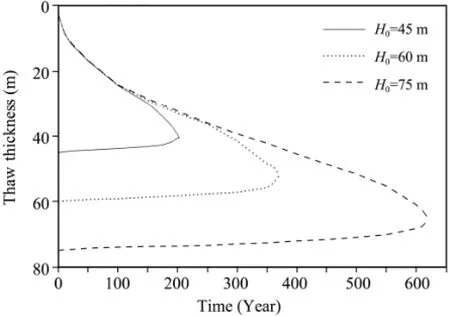
Figure 3 Variations in maximum top and bottom thaw thicknesses with time for the three simulation cases
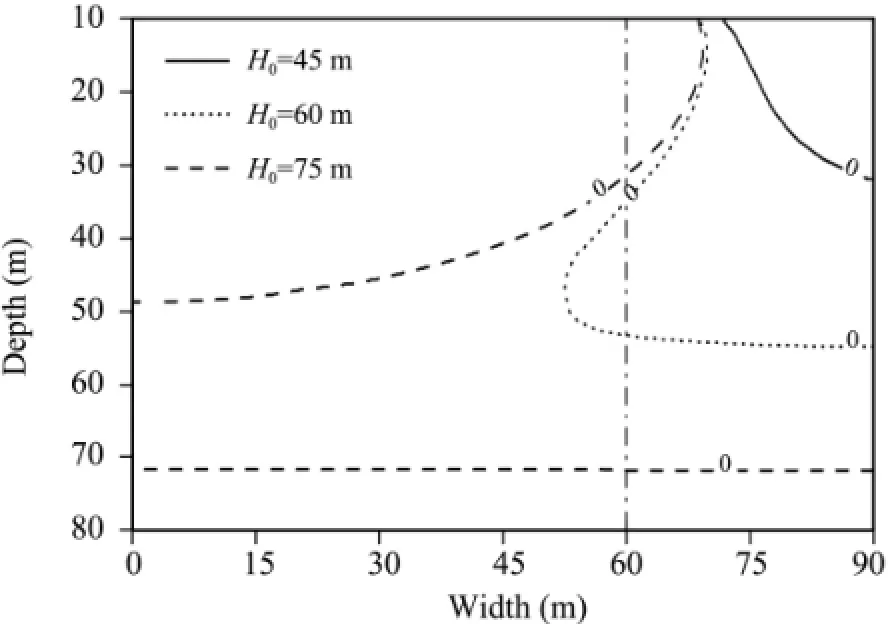
Figure 4 Simulated vertical profiles of the taliks on the last day of year 450 for simulation cases H45, H60, and H75

Table 3 The mean top thaw rate and the corresponding mean bottom thaw rate of permafrost under the modeled thermokarst lake for the three simulation cases
After the formation of an open talik, the contour line of the open talik advanced outward from the lake center. In order to evaluate the differences in the talik development processes caused by the differences in permafrost thickness, especially the lateral thaw processes after the formation of the open taliks, we used an index of the permafrost lateral thaw duration. We defined this index as the time from the year in which the open talik just formed to the year in which the distance from the profile of the open talik to the lake centerline equaled the lake radius of 60 m. The distance from the profile of the open talik to the lake centerline was defined as the minimum horizontal distance between the open talik margin and the lake centerline. Figure 5 shows the minimum horizontal distanced.
The simulated permafrost lateral thaw durations and the corresponding permafrost mean lateral thaw rates under the modeled thermokarst lake for the three simulation cases are summarized in table 4. Increasing the permafrost thickness of 45 m by 33.3% and 66.7% led to the permafrost lateral thaw duration increasing from 68 years to 126 years and 193 years, 28.86% and 46.54%, respectively. This also resulted in the permafrost mean lateral thaw rate decreasing from 88.26 cm/a to 47.62 cm/a and 31.09 cm/a, 6.73% and 30.04%, respectively. For each simulation case, the permafrost mean lateral thaw rate presented in table 4 was much faster than permafrost mean top thaw rate shown in table 3. This is no surprise because the permafrost was warmed during the lateral thaw period after the formation of the open talik. Increases in permafrost thickness not only strongly retarded the open talik formation time under the thermokarst lake, but also delayed the permafrost lateral thaw process after the formation of the open talik.

Figure 5 Schematic illustration of the distance from the profile of the open talik to the lake centerline. Permafrost under the modeled thermokarst lake was regarded as thawed completely if the distancedwas greater than or equal to the lake radius of 60 m.

Table 4 Permafrost lateral thaw durations and the corresponding permafrost mean lateral thaw rates for the three simulation cases
4 Discussion
Permafrost in the Barrow area on the Alaskan Arctic coastal plain is cold, with a thickness of about 400 m (Lachenbruch and Marshall, 1969; Lachenbruchet al., 1982; Osterkamp, 2005). A previous study on the long-term influence of thermokarst lakes on the thermal regime of permafrost and talik development in the Barrow area indicated that, for thaw lakes with mean lake bottom temperatures of 1.0 °C, 2.0 °C, and 3.0 °C, the maximum talik thicknesses were 28.0 m, 43.0 m, and 53.2 m, respectively, at 3,000 years after the lake formation (Ling and Zhang, 2003). Since the age of lakes in the Barrow area seldom exceeds 3,500 years (Brown, 1965; Carson, 1969; Hinkelet al., 2003), usually there would be no open talik formations below a thaw lake in this area. Previous studies have rarely addressed the formation of the open taliks and permafrost lateral thaw processes under thermokarst lakes after the formation ofopen taliks.
In contrast, permafrost in the Beiluhe Basin is characterized by relative thinness, high ground temperature, and high ice content (Cheng and Wu, 2007; Niuet al., 2011). Permafrost in this area thus is extremely sensitive to environmental change. Open taliks will form under thermokarst lakes and permafrost lateral thaw will proceed over time. In the absence of continuous long-term monitoring records in the Beiluhe Basin, an alternative is simulation of permafrost thermal regime beneath thermokarst lakes and its sensitivity to environment change with a numerical model that has been well-tuned and validated against field measurements. One of our recent studies investigated the permafrost lateral thaw process after the formation of an open talik (Linget al., 2012). In comparison, this study examined the response of talik development under a thermokarst lake to permafrost thickness. All of these studies have provided a basis for further understanding the roles of thermokarst lakes, the energy-related processes controlling the regional geomorphology, and permafrost lateral thaw process after the formation of open taliks on the QTP.
The thaw lake cycle consists of lake initiation, expansion, shrinkage, drainage, and finally re-establishment of ice-rich permafrost (Hinkelet al., 2003; Jorgenson and Shur, 2007). Previous observed data showed that any pre-existing permafrost below the center of this monitored lake has thawed entirely, the minimum ground temperature beneath the centerline of this lake was as high as 0.4 °C in 2008, the adjacent permafrost is eroding and degrading, and the monitored lake has not drained or shrunk to date (Linet al., 2011; Linget al., 2012). Based on these observations, this study assumed that the simulated thermokarst lake does not drain or shrink over time.
Natural thermokarst lakes expand their basins by coupled heat conduction and thawing of permafrost and geomorphic processes such as slumps (Murton, 2001; Plug and West, 2009). The lake radiuses will increase by bank retreat (Williams and Smith, 1989; Hinkelet al., 2003; Ling and Zhang, 2004a). Therefore, an accurate method for describing a thermokarst lake should use a physically-based model that accounts for lake initiation and lake expansion by permafrost thaw and mass wasting. Several researchers have developed models to describe lake orientation (Pelletier, 2005) and lake dynamic morphology (West and Plug, 2008). As a first attempt on the basis of those previous studies, Plug and West (2009) presented a two-dimensional numerical model of thaw lake expansion in cross section which combines heat transfer with mass movement and thaw-driven subsidence. Their model provides a better way to simulate the thermal regime of permafrost surrounding shallow thaw lakes. However, as noted by the authors, this model was based on a large amount of bathymetric and morphologic observation data. Long-term measurements of lake expansion (more than 20 years of measurements from more than 50 lake cross sections) may be required.
Therefore, the goal of this study was to investigate the responses of the ground thermal regime and talik development processes under thermokarst lakes to variations in permafrost thickness in the Beiluhe Basin under identical climates. Because there is a lack of complete, long-term field measurement data of lake expansion in the Beiluhe Basin, we had to assume that a thermokarst lake appeared in a mature form just after model initiation to simplify the simulation, and that the lake geometry did not change for 900 years. In modeling, simplification is essential if the goal is insight. Models with fewer moving parts are easier to grasp, more clearly connect cause and effect, and are harder to fiddle to match observations. More complexity is not necessarily better (Paola, 2011). To further understand the impact of such lakes, we carried out a sensitivity analysis of the open-talik formation time and lateral thaw progress to increases in the lake radius caused by the active thermal erosion, the results of which will be presented in a forthcoming paper.
The numerical simulations in this study show that the change in permafrost thickness caused by climate change, topography, geothermal flux, and soil physical and thermal properties is an important factor affecting talik development and permafrost lateral thaw processes after the formation of an open talik beneath a thermokarst lake. Field measurement data are prerequisite for numerical simulation. Because lakes of different morphologies can display different expansion rates under a similar climate, the wide divergence of lake expansion estimates calls for better quantitation of lake formation and expansion rates in relation to climate change (Plug and West, 2009). In order to further test and extend our model, a comprehensive and long-term geological investigation of permafrost thickness, bathymetric and morphologic processes, and ground thermal gradients is clearly necessary.
5 Summary
We used a simplified transient finite element model for heat transfer with phase change under a cylindrical coordinate system to numerically examine the responses of talik development and ground thermal regime under a thermokarst lake, and lateral thaw processes after the formation of open taliks, to permafrost with different thicknesses in the Beiluhe Basin on the QTP. Three simulation cases were conducted by using permafrost thicknesses of 45 m, 60 m, and 75 m.
Our results showed that the modeled thermokarstlake was a significant heat source to permafrost and talik. Bowl-shaped taliks formed under the thermokarst lake and the talik thickness increased substantially over time. An open talik formed in a certain predicted year. The thermokarst lake continued to thaw the permafrost laterally under it and the volume of open talik beneath the lake increased gradually with time after the formation of the open talik. Permafrost below the lake was predicted to thaw completely in a certain year and permafrost under the lakeshore would then thaw laterally with time.
The open talik formation time and permafrost lateral thaw process after the formation of the open talik were very sensitive to permafrost thickness. Increasing the permafrost thickness from 45 m to 60 m and 75 m resulted in increasing the open talik formation time from 202 years to 371 years and 621 years, respectively, after the formation of the lake. The mean permafrost top thaw rate decreased from 19.06 cm/a to 13.56 cm/a and 10.19 cm/a, respectively. The complete thaw time of permafrost under the modeled thermokarst lake was retarded from 68 years to 126 years and 193 year after the formation of the open taliks, and the permafrost mean lateral thaw rate decreased from 88.26 cm/a to 47.62 cm/a and 31.09 cm/a, respectively.
Acknowledgments:
This study was supported by the National Natural Science Foundation of China (NSFC) (No. 41271076), the National Key Basic Research Program of China (No. 2010CB951402), and the Open Fund Project of the Institute of Plateau Meteorology, China Meteorological Administration (No. LPM2008019). Financial support does not constitute an endorsement of the views expressed in this article.
Bian D, Yang ZL, Li D,et al., 2009. The response of lake change to climate fluctuations in North Tibetan Plateau during last 30 years. Journal of Geographical Science, 19: 131-142. DOI: 10.1007/s11442-009-0131-z.
Black RF, Barksdale WL, 1949. Oriented lakes of northern Alaska. The Journal of Geology, 57: 105-118.
Brown J, 1965. Radiocarbon dating, Barrow, Alaska. Arctic, 18(1): 37-48.
Burn CR, 2005. Lake-bottom thermal regimes, western Arctic coast, Canada. Permafrost and Periglacial Processes, 16: 355-367. DOI: 10.1002/PPP.542
Cheng GD, Wu TH, 2007. Responses of permafrost to climate change and their environmental significance, Qinghai-Tibet Plateau. Journal of Geophysical Research, 112: F02S03. DOI: 10.1029/2006JF000631.
Hinkel KM, Eisner WR, Bockheim JG,et al., 2003. Spatial extent, age, and carbon stocks in drained thaw lake basins on the Barrow Peninsula, Alaska. Arctic, Antarctic, and Alpine Research, 35(3): 291-300.
Hinkel KM, Lenters JD, Sheng Y,et al., 2012a. Thermokarst lakes on the Arctic coastal plain of Alaska: Spatial and temporal variability in summer water temperature. Permafrost Periglacial Processes, 23: 207-217. DOI: 10.1002/ppp.1743.
Hinkel KM, Sheng Y, Lenters JD,et al., 2012b. Thermokarst lakes on the Arctic coastal plain of Alaska: Geomorphic controls on bathymetry. Permafrost Periglacial Processes, 23: 218-230. DOI: 10.1002/ppp.1744.
Hopkins DM, 1949. Thaw lakes and thaw sinks in the Imuruk lake area, Seward Peninsula. The Journal of Geology, 57: 119-131.
Huang WF, Li ZJ, Han HW,et al., 2011. Structural analysis of thermokarst lake ice in Beiluhe Basin, Qinghai-Tibet Plateau. Cold Regions Science and Technology, 72: 33-42. DOI: 10.1016/j.coldregions.2011.11.005.
Huang WF, Li ZJ, Han HW,et al., 2012. Effective thermal conductivity of thermokarst lake ice in Beiluhe Basin, Qinghai-Tibet Plateau. Cold Regions Science and Technology, 85: 34-41. DOI: 10.1016/j.coldregions.2012.08.001.
化合物 3A01:质谱 ESI/MS(negative mode),m/z 200,[M-H]-。 1H NMR(500 MHz,CDCl3,TMS),δ为7.25~7.28(t,J=9.0 Hz,2H),7.04(t,J=9.0 Hz,2H),6.87(br.s,1H,NH),4.46(d,J=5.5Hz,2H),4.10 (s,2H)。
Johnston GH, Brown JE, 1966. Occurrence of permafrost at an Arctic lake. Nature, 21: 952-953.
Jorgenson MT, Shur Y, 2007. Evolution of lakes and basins in northern Alaska and discussion of the thaw lake cycle. Journal of Geophysical Research. 112(F02S17). DOI: 10.1029/ 2006JF000531.
Kokelj SV, Lantz TC, Kanigan J,et al., 2009. Origin and polycyclic behavior of tundra thaw slumps, Mackenzie Delta region, Northwest Territories, Canada. Permafrost and Periglacial Processes, 20: 173-184. DOI: 10.1002/ppp.642.
Lachenbruch AH, Marshall BV, 1969. Heat flow in the Arctic. Arctic, 22: 300-311.
Lachenbruch AH, Sass JH, Marshall BV,et al., 1982. Temperatures, heat flow, and the geothermal regime at Prudhoe Bay, Alaska. Journal of Geophysical Research, 87(B11): 9301-9316.
Lachenbruch AH, Marshall BV, 1986. Changing climate: Geothermal evidence from permafrost in the Alaskan Arctic. Science, 234(4777): 689-696.
Li SX, Cheng GD, Guo DX, 1996. The future thermal regime of numerical simulating permafrost on Qinghai-Xizang (Tibet) Plateau, China, under climate warming. Science in China (Series D), 39(4): 434-441.
Li, SX, Wu TH, 2004. Permafrost temperature regime: Study method and applied analysis. Journal of Glaciology and Geocryology, 26(4): 377-383.
Lin ZJ, Niu FJ, Ge J,et al., 2010a. Variation characteristics of thaw lakes in permafrost regions of the Qinghai-Tibet Plateau and its influence on the thermal state of permafrost. Journal of Glaciology and Geocryology, 32(2): 341-349.
Lin ZJ, Niu FJ, Xu Z,et al., 2010b. Thermal regime of a thermokarst lake and its influence on permafrost, Beiluhe Basin, Qinghai-Tibet Plateau. Permafrost and Periglacial Processes, 21(4): 315-324. DOI: 10.1002/ppp.692.
Lin ZJ, Niu FJ, Liu H,et al., 2011. Hydrothermal processes of alpine tundra lakes, Beiluhe Basin, Qinghai-Tibet Plateau. Cold Regions Science and Technology, 65(3): 446-455. DOI: 10.1016/j.coldregions.2010.10.013.
Lin, ZJ, Niu FJ, Liu H,et al., 2013. Numerical simulation of permafrost degradation under the influence of thaw lake on the Qinghai-Tibet Plateau. Acta Geologica Sinica, 87(5): 737-746.
Ling F, Zhang TJ, 2003. Numerical simulation of permafrostthermal regime and talik development under shallow thermokarst lakes on the Alaskan Arctic coastal plain. Journal of Geophysical Research, 108(D16): 26-36. DOI: 10.1029/ 2002JD003014.
Ling F, Zhang TJ, 2004a. Modeling study of talik freeze-up and permafrost response under drained thaw lakes on the Alaskan Arctic coastal plain. Journal of Geophysical Research, 109: D01111. DOI: 10.1029/2003JD003886.
Ling F, Zhang T, 2004b. A numerical model for surface energy balance and thermal regime of the active layer and permafrost containing unfrozen water. Cold Regions Science and Technology, 38(1): 1-15. DOI: 10.1016/S0165-232X(03)00057-0.
Ling F, Wu QB, Zhang TJ,et al., 2012. Modeling talik development and permafrost lateral thaw under a thermokarst lake, Beiluhe Basin, Qinghai-Tibet Plateau. Permafrost and Periglacial Processes, 23(4): 321-312. DOI: 10.1002/ppp.1754.
Liu JS, Wang S, Yu S,et al., 2009. Climate warming and growth of high-elevation inland lakes on the Tibetan Plateau. Global and Planetary Change, 67: 209-217.
Lunardini VJ, 1981. Heat Transfer in Cold Climates. Van Nostrand Reinhold, New York, pp. 108-146.
Lunardini VJ, 1995. Permafrost formation time. CRREL Report 95-8, Cold Regions Research and Engineering Laboratory, Hanover, NH, pp. 1-12.
Mackay JR, 1997. A full-scale field experiment (1978-1995) on the growth of permafrost by means of lake drainage, western Arctic coast: A discussion of the method and some results. Canadian Journal of Earth Sciences, 34: 17-33.
Murton JB, 2001. Thermokarst sediment and sedimentary structures, Tuktoyaktuk Coastlands, western Arctic Canada. Sedementology, 43: 737-760.
Niu FJ, Zhang JM, Zhang Z, 2002. Engineering geological characteristics and evaluations of permafrost in Beiluhe testing field of the Qinghai-Tibet Railway. Journal of Glaciology and Geocryology, 24: 264-269.
Niu FJ, Lin ZJ, Liu H,et al., 2011. Characteristics of thermokarst lakes and their influence on permafrost in Qinghai-Tibet Plateau. Geomorphology, 132: 222-233. DOI: http://dx.doi.org/ 10.1016/j.geomorph.2013.07.011.
Niu FJ, Dong C, Lin ZJ,et al., 2013. Distribution of thermokarst lakes and its thermal influence on permafrost along Qinghai-Tibet Highway. Advances in Earth Science, 28(6): 695-702.
Osterkamp TE, Gosink JP, 1991. Variations in permafrost thickness in response to changes in paleo-climate. Journal of Geophysical Research, 96(B3): 4423-4434.
Osterkamp TE, 2005. The recent warming of permafrost in Alaska. Global and Planetary Change, 49: 187-202. DOI: 10.1016/ j.loplacha.2005.09.001.
Paola C, 2011. In modelling, simplicity isn’t simple. Nature, 469(7328): 38-38.
Pelletier JD, 2005. Formation of oriented thaw lakes by thaw slumping. Journal of Geophysical Research, 110: F02018. DOI: 10.1029/2004JF000158.
Plug LJ, West JJ, 2009. Thaw lake expansion in a two-dimensional coupled model of heat transfer, thaw subsidence, and mass movement. Journal of Geophysical Research, 114: F01002. DOI: 10.1029/2006JF000740.
Sellmann PV, Brown J, Lewellen RL,et al., 1975. The classification and geomorphic implications of thaw lakes on the Arctic coastal plain, Alaska. CRREL Research Report 344, Cold Regions Research and Engineering Laboratory, Hanover, NH.
Sun ZZ, Liu MH, Wu GL,et al., 2013. Characteristics of permafrost under a non-penetrative thermokarst lake in Beiluhe Basin on the Tibetan Plateau. Journal of Glaciology and Geocryology, 34(1): 37-42.
West JJ, Plug LJ, 2008. Time-dependent morphology of thaw lakes and taliks in deep and shallow ground ice. Journal of Geophysical Research, 113: F01009. DOI: 10.1029/2006JF000696.
Williams PJ, Smith MW, 1989. The Frozen Earth: Fundamentals of Geocryology. Cambridge University Press, Cambridge, UK, pp. 174-232.
Wu QB, Zhang TJ, 2008. Permafrost warming on the Qinghai-Tibetan Plateau. Journal of Geophysical Research, 113: D13108. DOI: 10.1029/2007JD009539.
Wu QB, Zhang TJ, 2010. Permafrost temperatures and thickness on the Qinghai-Tibet Plateau. Global and Planetary Change, 72: 32-38. DOI: 10.1016/j.gloplacha.2010.03.001.
Xu XZ, Deng YS, 1991. The Experimental Research on Moisture Transfer in Frozen Soil. Science Press, Beijing, pp. 82-86.
Yoshikawa K, Hinzman LD, 2003. Shrinking thermokarst ponds and groundwater dynamics in discontinuous permafrost near Council, Alaska. Permafrost Periglacial Processes, 14: 151-160. DOI: 10.1002/ppp.451.
Zhou YW, Guo DX, Qiu GQ,et al., 2000. Geocryology in China. Science Press, Beijing, pp. 9-36.
: Ling F, Wu QB, Niu FJ,et al., 2014. Modeled response of talik development under thermokarst lakes to permafrost thickness on the Qinghai-Tibet Plateau. Sciences in Cold and Arid Regions, 6(6): 0521-0530.
10.3724/SP.J.1226.2014.00521.
Received: June 13, 2014 Accepted: October 11, 2014
*Correspondence to: Dr. Feng Ling, Professor of School of Mathematics and Statistics, Zhaoqing University. Duanzhou District, Zhaoqing, Guangdong 526061, China. Tel: +86-758-2752185; E-mail: lingf@zqu.edu.cn
 Sciences in Cold and Arid Regions2014年6期
Sciences in Cold and Arid Regions2014年6期
- Sciences in Cold and Arid Regions的其它文章
- Variations of the temperature and solar activity in China
- Study on the extremely cold winter of 1670 over the middle and lower reaches of the Yangtze River
- Climatic response of Pinus sylvestris var. mongolica tree-ring width and precipitation reconstruction for the northern Greater Higgnan Mountains, China, since 1720
- Impacts of reduced wind speed on physiology and ecosystem carbon flux of a semi-arid steppe ecosystem
- Study on dynamic changes of land desertification in the circum-lake zone of the Qinghai Lake in the past 30 years supported by Remote Sensing and Geographical Information System
- An estimation of groundwater storage variations from GRACE gravity satellites in the Heihe River Basin, northwestern China
